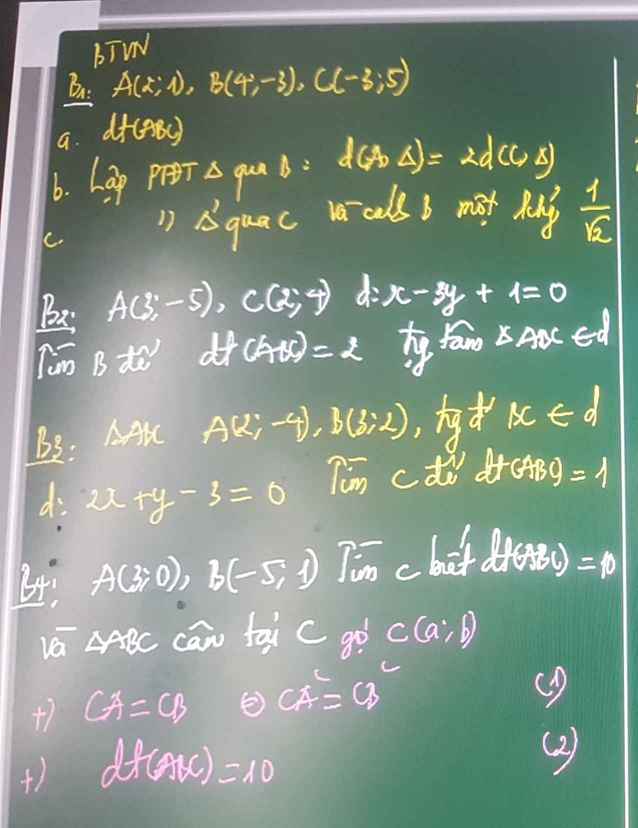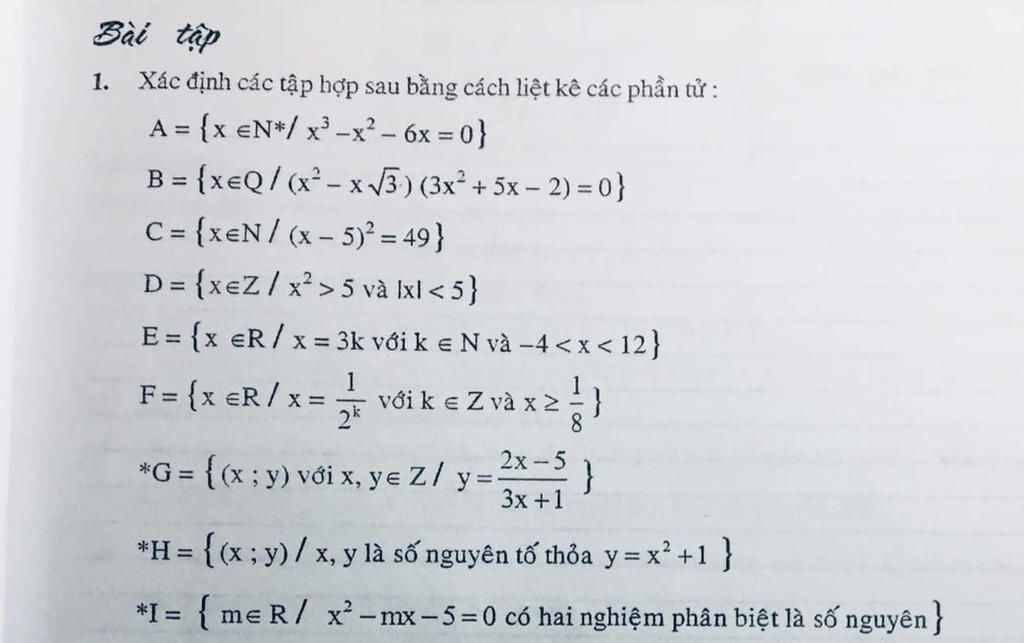
Hãy nhập câu hỏi của bạn vào đây, nếu là tài khoản VIP, bạn sẽ được ưu tiên trả lời.


`sin3x sinx+sin(x-π/3) cos (x-π/6)=0`
`<=> 1/2 (cos2x - cos4x) + 1/2(-sin π/6 + sin (2x-π/2)=0`
`<=> cos2x-cos4x-1/2+ sin(2x-π/2)=0`
`<=>cos2x-cos4x-1/2+ sin2x .cos π/2 - cos2x. sinπ/2=0`
`<=> cos2x - cos4x - cos2x = 1/2`
`<=> cos4x = cos(2π)/3`
`<=>` \(\left[{}\begin{matrix}4x=\dfrac{2\text{π}}{3}+k2\text{π}\\4x=\dfrac{-2\text{π}}{3}+k2\text{π}\end{matrix}\right.\)
`<=>` \(\left[{}\begin{matrix}x=\dfrac{\text{π}}{6}+k\dfrac{\text{π}}{2}\\x=-\dfrac{\text{π}}{6}+k\dfrac{\text{π}}{2}\end{matrix}\right.\)

Bài 20
Hệ (1) ⇔ \(\left\{{}\begin{matrix}1< x< 4\\x\le m-1\end{matrix}\right.\)
Đặt hai tập hợp A = (1 ; 4) và B = (\(-\infty\); m - 1]
Nếu m - 1 ≤ 1 tức m ≤ 2 thì A \(\cap\) B = ∅, hệ vô nghiệm
Nếu 1 < m - 1 < 4 tức 2 < m < 5 thì
A \(\cap\) B = (1; m - 1), tập nghiệm của hệ là (1; m - 1)
Nếu m - 1 ≥ 4 tức m ≥ 5 thì A \(\subset\) B. Tập nghiệm của hệ là A = (1; 4)




a) \(d\left(A;\Delta\right)=\dfrac{\left|4.1-3.3+2\right|}{\sqrt{4^2+\left(-3\right)^2}}=\dfrac{3}{5}\)
b) \(\overrightarrow{AB}=\left(-3;-2\right)\) là VTCP của đường thẳng d
PT tham số của d: \(\left\{{}\begin{matrix}x=1-3t\\y=3-2t\end{matrix}\right.\left(t\in R\right)\)
c) Đường tròn (C) có bán kính \(R=AB=\sqrt{\left(1+2\right)^2+\left(3-1\right)^2}=\sqrt{13}\)
PT đường tròn (C): \(\left(x-1\right)^2+\left(y-3\right)^2=13\)


a.
$x^3-x^2-6x=0$
$\Leftrightarrow x(x^2-x-6)=0$
$\Leftrightarrow x[x(x+2)-3(x+2)]=0$
$\Leftrightarrow x(x+2)(x-3)=0$
$\Leftrightarrow x=0$ hoặc $x+2=0$ hoặc $x-3=0$
$\Leftrightarrow x=0$ hoặc $x=-2$ hoặc $x=3$
Vì $x\in\mathbb{N}^*$ nên $x=3$
Vậy $A=\left\{3\right\}$
------------------------------
b.
$(x^2-x\sqrt{3})(3x^2+5x-2)=0$
$\Leftrightarrow x(x-\sqrt{3})[x(3x-1)+2(3x-1)]=0$
$\Leftrightarrow x(x-\sqrt{3})(3x-1)(x+2)=0$
$\Leftrightarrow x=0$ hoặc $x-\sqrt{3}=0$ hoặc $3x-1=0$ hoặc $x+2=0$
$\Leftrightarrow x\in\left\{0; \sqrt{3}; \frac{1}{3}; -2\right\}$
Vì $x\in\mathbb{Q}$ nên $x\in\left\{0; \frac{1}{3}; -2\right\}$
Vậy $B=\left\{0; \frac{1}{3}; -2\right\}$
c.
$(x-5)^2=49$
$\Leftrightarrow (x-5)^2=7^2=(-7)^2$
$\Leftrightarrow x-5=7$ hoặc $x-5=-7$
$\Leftrightarrow x=12$ hoặc $x=-2$
$x\in\mathbb{N}$ nên $x=12$
Vậy $C=\left\{12\right\}$
-------------------------------
d.
$|x|<5\Leftrightarrow -5< x< 5$
$x\in\mathbb{Z}\Rightarrow x\in\left\{-4; -3; -2; -1; 0; 1; 2;3;4\right\}$
Mà $x^2>5$ nên $x\in\left\{-4; -3; 3; 4\right\}$
Vậy $D=\left\{-4; -3; 3; 4\right\}$









1:
ĐKXĐ: \(-x^2+4x-2>=0\)
=>\(x^2-4x+2< =0\)
=>\(\left(x-2\right)^2-2< =0\)
=>\(-\sqrt{2}< =x-2< =\sqrt{2}\)
=>\(-\sqrt{2}+2< =x< =\sqrt{2}+2\)
\(\sqrt{-x^2+4x-2}=2-x\)
=>\(\left\{{}\begin{matrix}-x^2+4x-2=\left(2-x\right)^2\\2-x>=0\end{matrix}\right.\)
=>\(\left\{{}\begin{matrix}-x^2+4x-2=x^2-4x+4\\x< =2\end{matrix}\right.\)
=>\(\left\{{}\begin{matrix}-2x^2+8x-6=0\\2-\sqrt{2}< =x< =2\end{matrix}\right.\)
=>\(\left\{{}\begin{matrix}x^2-4x+3=0\\2-\sqrt{2}< =x< =2\end{matrix}\right.\)
=>\(\left\{{}\begin{matrix}\left(x-1\right)\left(x-3\right)=0\\2-\sqrt{2}< =x< =2\end{matrix}\right.\)
=>\(\left\{{}\begin{matrix}x\in\left\{1;3\right\}\\2-\sqrt{2}< =x< =2\end{matrix}\right.\)
=>x=1
2: Bạn xem lại đề giúp mình nha, sao lại có 2 dấu bằng?
2: đoạn cuối là x-1 đó ạ